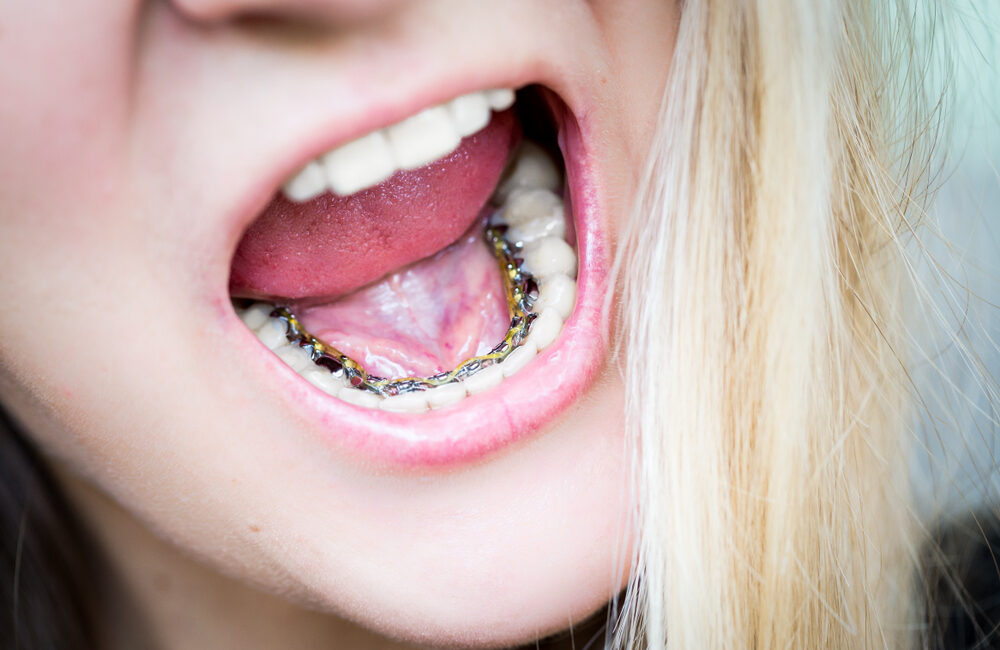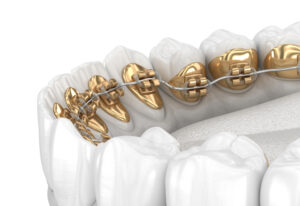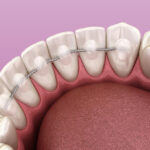
If you want to straighten your teeth without being conspicuous about it but you’re not a good candidate for clear plastic aligners, lingual braces might be the answer. In this orthodontic treatment approach, orthodontists mount the apparatus used to realign teeth (brackets, wires, and elastics) on the back (the tongue side) of the teeth instead of the front. The chief advantage of this approach is that it largely hides the braces from view, except perhaps when you yawn and don’t cover your mouth!
Lingual braces can be more efficient than clear plastic aligners in achieving complex movements like tooth rotation or changing the height of teeth.
How Braces Move Teeth
Although the location of the appliance used is reversed, conventional braces and lingual braces have many similarities in terms of the type of hardware and orthodontic principles involved. In both scenarios, they use thin, flexible wires that orthodontists thread through the brackets to slowly straighten teeth. These wires exert light pressure on the teeth, moving them in preplanned and controlled ways.
Teeth can move because they are not rigidly planted in the supporting jaw bone. Instead, elastic periodontal (“peri” = around; “dont” = tooth) ligaments suspend them like a hammock, with each tooth in its own socket within the bone. These ligaments attach on one end to the roots of teeth and on the other end to the surrounding jaw bone. The bone and ligaments are living tissue that renew or “remodel” themselves by shedding and adding cells in response to pressure from the tooth roots.
On the pressure side, which is ahead of the direction in which teeth are moving, the body absorbs bone and ligament tissues to make room, while on the tension side that teeth are moving away from, the body forms new bone and ligament to fill in the space. It can help to visualize this by imagining an upright stick being drawn through sand. The sand falls away in front of the advancing stick, and simultaneously fills in behind it.
What Are Porcelain Dental Veneers? Find out the answer here!
Special Considerations

While lingual treatment offers an aesthetic advantage, it comes with potential challenges that accompany all fixed orthodontic devices as well as some that are unique to the “backward” approach.
Adaptation and Speech Issues
Adjusting to wearing lingual braces typically requires more time than adapting to conventional ones. Initially, lingual braces may cause interference with your normal speech, as your tongue comes into contact with the backside of your upper front teeth when forming certain sounds – the same location where lingual braces are situated. Consequently, you may notice a lisp or a whistling sound during speech. Nevertheless, most people adapt over time to the presence of lingual braces, and they generally experience a reduction in these speech difficulties.
Tongue Irritation and Soothing Measures
Another potential problem, especially during the first few weeks of wearing new lingual braces, is tongue irritation from rubbing against the brackets and wires in the process of speaking and eating. Several options exist for soothing or countering this phenomenon. Frequent rinsing with warm saltwater can encourage healing. An over-the-counter product containing a mild anesthetic such as benzocaine can temporarily numb your tongue. You can place orthodontic wax, available from your orthodontist, dentist, or in the dental section of many drug stores, over the sharp edges of brackets and wires as a protective measure. And your orthodontist may be able to provide protective silicone pads to wear over the braces.
Challenges with Eating and Dental Care
Like other fixed orthodontic appliances, lingual braces can complicate eating. They trap food more easily, and you should avoid sticky, chewy, crunchy, or hard foods because they can damage brackets and wires and loosen the cement bond affixing the brackets to your teeth. All types of fixed braces can also complicate brushing and flossing and make it harder to avoid common dental problems like gingivitis (inflamed gums), tartar buildup, erosion of protective tooth enamel, and cavities (tooth decay).
Suitability for Patients
Lingual braces can work for adolescents/teens and adults alike, but they may not be the best choice in every case. The only way to know whether they are a viable option is in consultation with your orthodontist.














Leave a Reply